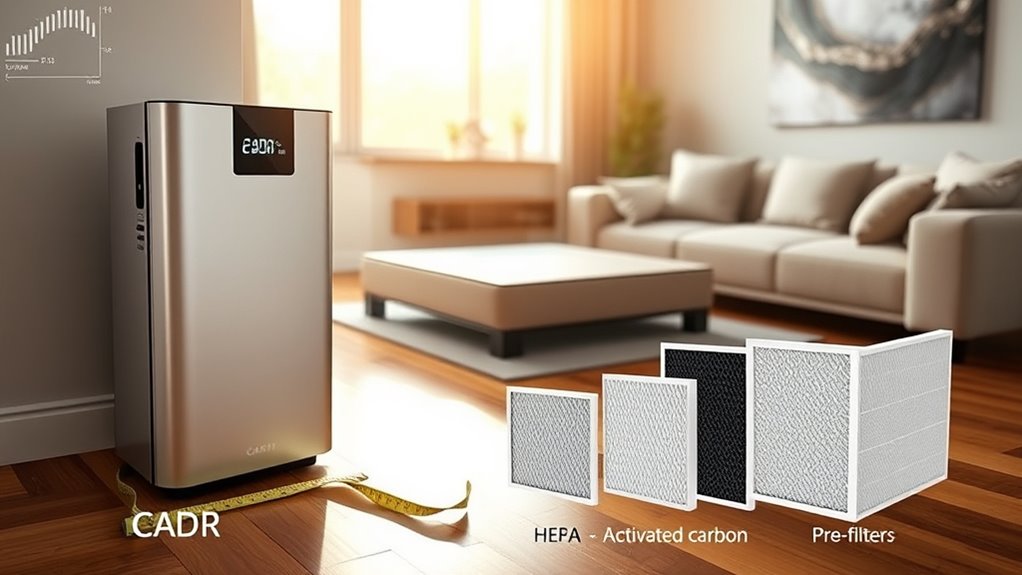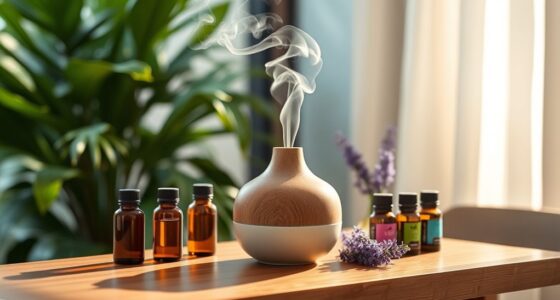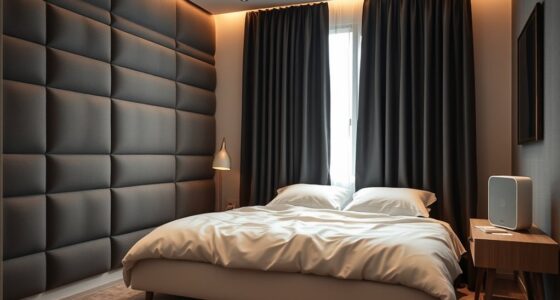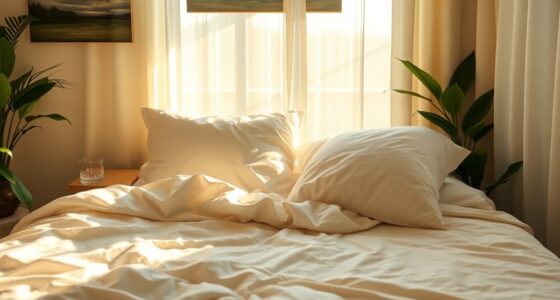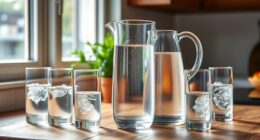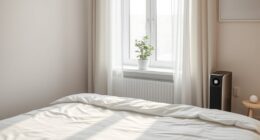When choosing an air purifier, focus on the Clean Air Delivery Rate (CADR). It should match at least two-thirds of your room size for ideal performance. Check the filter type too; HEPA filters are best for capturing tiny particles, while activated carbon filters tackle odors. Energy efficiency matters, so look for models with Energy Star ratings. Pay attention to noise levels to guarantee comfort. There’s more to think about that can enhance air quality and your overall experience.
Key Takeaways
- Ensure the CADR rating is at least two-thirds of the room size for effective air purification.
- Choose HEPA filters for superior particle capture and improved air quality.
- Look for activated carbon filters to effectively eliminate odors and gases, but note their frequent replacement needs.
- Select Energy Star certified models for enhanced energy efficiency and lower electricity costs.
- Consider air quality sensors and noise levels to optimize performance and user comfort in various environments.
Understanding Clean Air Delivery Rate (CADR)
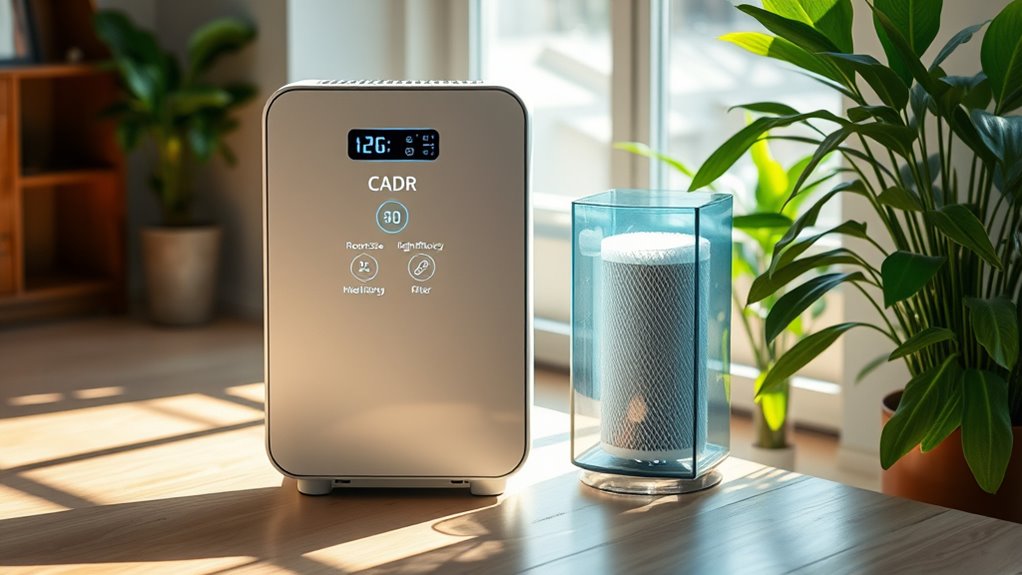
When choosing an air purifier, understanding the Clean Air Delivery Rate (CADR) is essential for ensuring you get the right one for your space.
CADR measures the volume of filtered air delivered, expressed in cubic feet per minute (CFM) for smoke, dust, and pollen. A higher CADR means a more efficient air purification system. Additionally, many high-quality air purifiers utilize HEPA filter technology to enhance their effectiveness. Regular filter replacement is also a key factor in maintaining optimal performance over time. Furthermore, air purifiers with auto functionality can automatically adjust their operation based on real-time air quality, adding to their efficiency. Consistent maintenance and cleaning of your air purifier ensures it continues to operate effectively and efficiently.
It’s recommended that the CADR should be at least two-thirds of your room size in square feet for effective air cleaning. For instance, in a 300 square foot room, aim for a CADR of at least 200 CFM.
The Association of Home Appliance Manufacturers standardizes these ratings, helping you compare performance across different air purifiers. Additionally, choosing an air purifier with HEPA filters can significantly enhance the removal of airborne particles, ensuring cleaner air quality.
The Association of Home Appliance Manufacturers provides standardized ratings, enabling effective comparison of air purifier performance.
Consider the filter type to maximize pollutant removal, including particulate matter.
Assessing Room Size for Air Purifiers
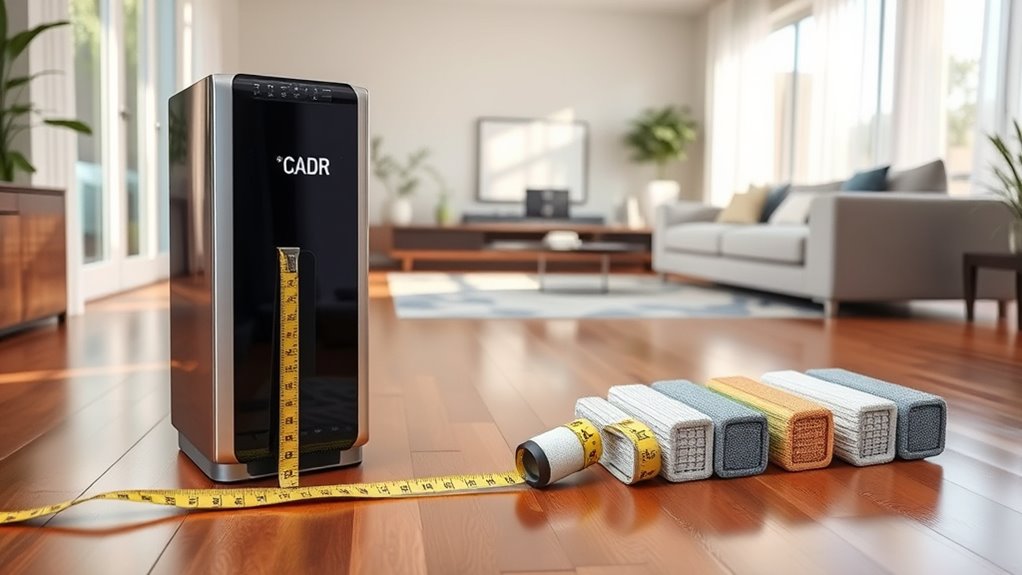
Choosing the right air purifier goes beyond just understanding CADR; evaluating your room size is equally important.
Start by measuring the length, width, and height to calculate the cubic volume, which helps determine how much air needs purifying. For effective air cleaning, small rooms—typically 92 to 250 square feet—should have a CADR rating of at least two-thirds of the room’s area. Additionally, ensure you maintain efficiency by regularly checking and cleaning the filters of your air purifier. Poor air quality can exacerbate health issues, especially for vulnerable populations who can benefit from improved indoor air quality. Regular maintenance can also help extend appliance lifespan, ensuring your air purifier operates effectively. Furthermore, consider implementing preventive maintenance strategies to keep your air purifier functioning optimally over time.
If your space is irregularly shaped, divide it into rectangles to accurately assess square footage. Look for air purifiers with the AHAM Verifide seal, ensuring they’re effective for your specific room size. Additionally, consider models with HEPA filtration to maximize allergen removal and improve overall air quality.
Selecting the right model will greatly enhance indoor air quality, making your home a healthier environment.
Importance of Filter Type in Air Purifiers
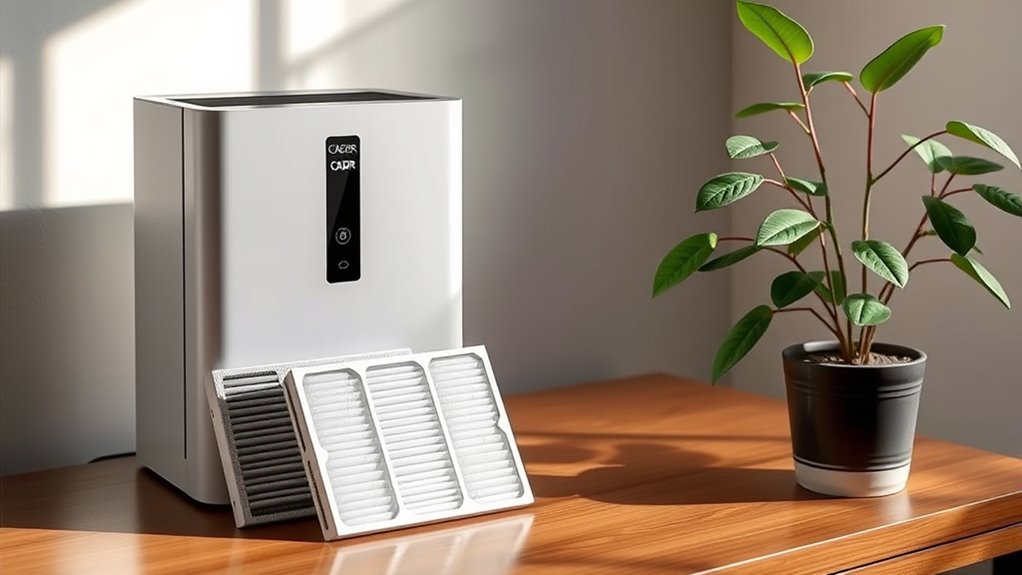
How can the type of filter in your air purifier affect the air quality in your home? The effectiveness of air purifiers largely depends on the filter types they use.
HEPA filters can capture 99.97% of airborne particles as small as 0.3 micrometers, making them fantastic for trapping allergens and dust. Additionally, many robot vacuum cleaners also utilize advanced filters to enhance their cleaning capabilities, ensuring a cleaner environment. Activated carbon filters, on the other hand, excel at removing odors and gases but need to be replaced every three months. The best air purifiers often feature a combination of these filters for optimal performance. Furthermore, using air purifiers with high-performance ratings can significantly improve indoor air quality in various environments. Many top-rated vacuums are designed to work in conjunction with air purifiers to create a comprehensive cleaning system within the home.
Mechanical filters also work well for various particle sizes, requiring replacement every 6-12 months. It’s important to avoid ozone-generating devices, as they pose health risks and don’t effectively remove pollutants. Additionally, regular maintenance tips for paint sprayers can be applied to air purifiers to ensure they function efficiently.
Regularly replace your filter for peak performance and cleaner air in your living space.
Evaluating Energy Efficiency Ratings
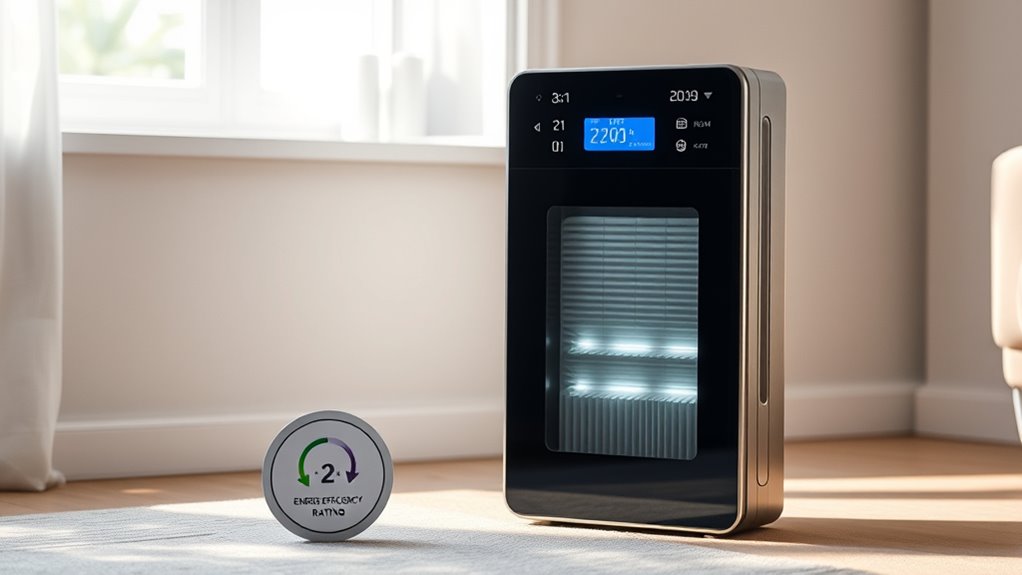
Understanding energy efficiency ratings is vital for selecting an air purifier that not only cleans the air effectively but also keeps your energy bills in check.
Look for models with Energy Star certification, as these are 40% more energy-efficient than standard options, reducing operational costs over time. Airless paint sprayers also utilize adjustable pressure settings to enhance efficiency and reduce waste.
Pay attention to the wattage; air purifiers usually range from 20 to 100 watts, with lower wattage models saving you money on electricity. Additionally, opting for devices with higher energy efficiency ratings can lead to even more substantial savings on your energy bills. For instance, air purifiers with higher Clean Air Delivery Rate (CADR) can effectively purify the air without consuming excessive energy. Moreover, selecting models that utilize renewable energy sources can further improve their environmental impact.
The Clean Air Delivery Rate (CADR) is also important—higher CADR means better purification without greatly increasing energy consumption.
Finally, regular maintenance, including timely filter replacements, guarantees your unit operates efficiently, preventing clogged filters from raising your overall energy consumption and operational costs. Regular maintenance of vacuum cleaners can similarly enhance performance and longevity.
Additional Features to Enhance Performance
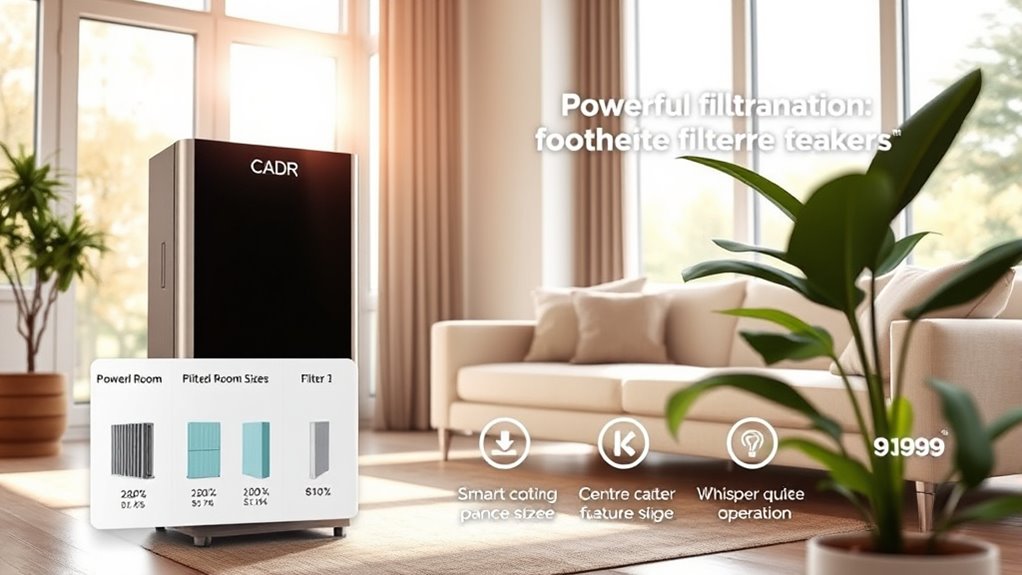
While not every air purifier is created equal, several additional features can greatly enhance its performance and your overall experience. Here are three key features to take into account:
Not all air purifiers are the same; consider key features for improved performance and user experience.
- Air Quality Sensors: These sensors automatically adjust cleaning speed based on real-time pollution levels, ensuring ideal performance and energy efficiency. Additionally, mindfulness practices can be beneficial in creating a healthy living environment, as they promote awareness of air quality and its impact on well-being. Maintaining good air quality is essential, as it can influence hamster health and overall pet well-being.
- Filter Service Indicator: This handy light alerts you when it’s time to replace or clean filters, helping maintain peak filtration effectiveness.
- WiFi Capability: With this feature, you can monitor and control your purifier remotely using a smartphone app, adding convenience to your life.
Additionally, consider models with features like solar-powered solutions that can enhance energy efficiency while purifying the air. Also, look for washable prefilters that capture larger particles, and think about models with carrying handles and wheels for easy portability.
These features make managing air quality simpler and more efficient, which aligns with the importance of cultural intelligence in adapting products to meet diverse consumer needs.
Noise Levels and Their Impact on Usage

When choosing an air purifier, noise levels can considerably impact your comfort and usage.
Ideally, you’ll want a model that operates around 50 dB for quiet environments like bedrooms or offices.
Luckily, many purifiers offer quiet modes and varying fan speeds to suit your needs.
Noise Level Measurement
How much noise can you tolerate while trying to breathe clean air? The noise level of air purifiers, measured in decibels (dB), is essential for your comfort.
Ideally, look for models around 50 dB for quiet operation, especially in bedrooms.
Consider these factors:
- Speed Settings: Choose high-speed settings for maximum air cleaning during the day, but switch to lower settings at night to minimize noise.
- Consumer Reports: Some purifiers exceed 60 dB on high, which can disrupt quiet environments.
- Proper Placement: Position your purifier away from sleeping areas and opt for models designed for quiet operation to enhance overall comfort.
Finding the right balance guarantees you breathe clean air without noise interference.
Ideal Operating Volume
Choosing the right noise level for your air purifier can markedly impact your daily life, especially in spaces where peace and quiet are essential. The ideal noise level lies around 50 decibels, akin to a quiet conversation. Opt for models with adjustable fan speeds and a quiet mode, which allows effective filtering while minimizing disturbances during sleep or concentration.
| Noise Level (dB) | Fan Speed Setting |
|---|---|
| 30 | Quiet mode |
| 50 | Medium speed |
| 70 | High speed |
When selecting an air purifier, balance the noise level with its Clean Air Delivery Rate (CADR) to guarantee you’re getting efficient air cleaning without excessive sound, particularly in your designated room size.
Quiet Models Available
Which quiet models are truly worth considering for your home? When selecting an air purifier, especially for bedrooms, you’ll want one that balances effective air cleaning with minimal noise levels.
Here are three standout options:
- Coway Airmega AP-1512HH – Operating at just 24.3 dB on its lowest setting, it’s perfect for maintaining comfort during sleep.
- Sound-Dampening Technology Models – These purifiers keep noise levels low even at higher fan speeds, making them ideal for daily activities.
- Multiple Fan Speeds – This feature allows you to adjust settings according to your needs, ensuring you can choose a quiet operation when desired.
With the right filtration system, these quiet air purifiers enhance your environment without disrupting your peace.
Maintenance Considerations for Longevity
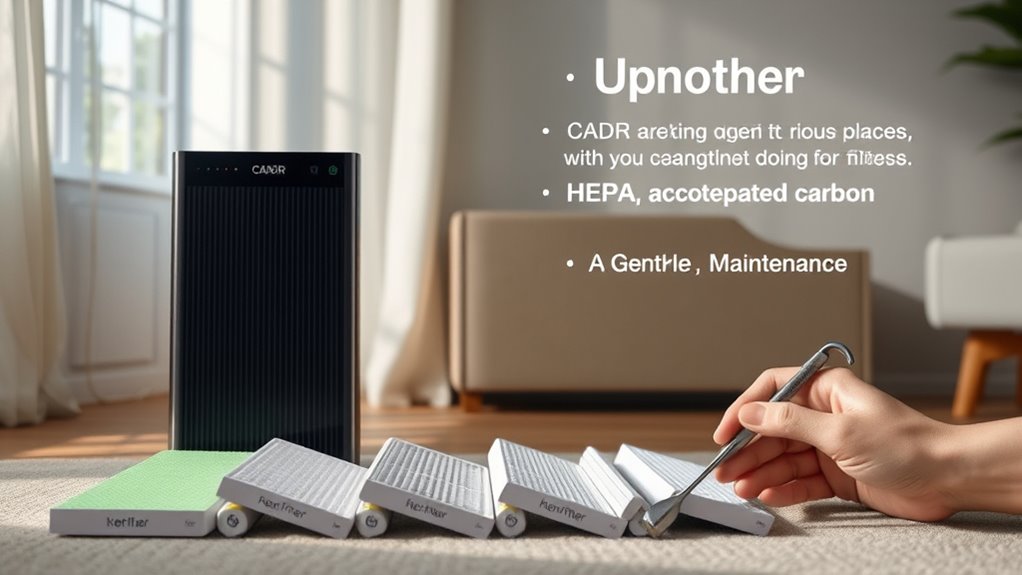
To guarantee your air purifier remains effective and lasts longer, regular maintenance is essential. Addressing filter needs through timely replacement or cleaning is vital for peak air purifier performance. Many units come with a filter service indicator, alerting you when it’s time to act.
| Filter Type | Replacement Frequency | Maintenance Tip |
|---|---|---|
| Mechanical Filters | Every 6-12 months | Replace for efficiency |
| Activated Carbon | Every 3 months | Change to maintain quality |
| Routine Maintenance | Monthly | Dust and check for obstructions |
| Airflow Improvement | Ongoing | Keep the area ventilated |
Frequently Asked Questions
What Is a Good CADR for an Air Purifier?
A good CADR for an air purifier really depends on your room size and the pollutants you want to tackle.
For effective air cleaning, aim for a CADR that’s at least two-thirds of your room size in square feet.
If you’re in a 300 sq ft room, look for a CADR around 200 CFM or higher.
This guarantees you’re getting clean air efficiently, making your environment healthier and more comfortable.
What Should I Look for in an Air Purifier?
Did you know that indoor air can be up to five times more polluted than outdoor air?
When you’re choosing an air purifier, it’s crucial to evaluate several factors. Look for a model that suits your room size, ensuring peak performance.
Pay attention to the noise levels, especially if you plan to use it in a quiet space.
Finally, think about the cost of filter replacements to avoid surprises down the line.
What Kind of Filter Is Best for Air Purifier?
When choosing a filter for your air purifier, you’ll want to prioritize HEPA filters. They capture 99.97% of tiny particles, making them ideal for allergens like dust and pollen.
Activated carbon filters are great for absorbing odors and gases but don’t filter particulates as effectively.
Avoid ozone generators, as they can pose health risks.
For the best results, look for devices that combine HEPA and activated carbon filters to tackle a wide range of contaminants.
How to Judge a Good Air Purifier?
To judge a good air purifier, start by checking its performance. Look for how effectively it cleans the air and whether it meets your specific needs.
Consider its noise levels and ease of use, too. You’ll want a model that fits seamlessly into your lifestyle, whether that means easy controls or a sleek design.
Finally, read reviews to see what other users say about their experiences. This’ll help you make an informed choice.
Conclusion
When choosing an air purifier, remember to take into account CADR for efficiency, room size for effectiveness, and filter type for quality. Look for energy efficiency to save on bills, additional features for enhanced performance, and noise levels for a peaceful environment. Finally, prioritize maintenance to guarantee longevity. By focusing on these key elements, you’ll not only breathe easier but also create a healthier home, making the air you share cleaner, fresher, and more enjoyable for everyone.
